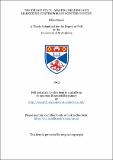Files in this item
The dream state : making, reading and marketing contemporary Scottish poetry
Item metadata
| dc.contributor.advisor | Crawford, Robert | |
| dc.contributor.author | Fraser, Lilias | |
| dc.coverage.spatial | 365 p. | en_US |
| dc.date.accessioned | 2018-07-04T11:45:45Z | |
| dc.date.available | 2018-07-04T11:45:45Z | |
| dc.date.issued | 2003 | |
| dc.identifier.uri | https://hdl.handle.net/10023/14912 | |
| dc.description.abstract | This thesis investigates aspects of the writing, reading, and marketing of contemporary Scottish poetry, suggesting that readers of contemporary poetry are influenced in their reading by marketplace forces as well as by their early academic training. The thesis attempts to reflect this combination of influences on the reader, but it also seeks to reflect the awareness of these influences in the poets' work. The Dream State concentrates on factors which condition the reading of contemporary Scottish poetry, and on some of the poetry of seven poets who became established in the 1990s: John Burnside, Robert Crawford, W. N. Herbert, Tracey Herd, Kathleen Jamie, Don Paterson and Robin Robertson. Alert to the political climate of Scottish devolution and to a literary climate which saw the simultaneous appearance of the anthology Dream State: The New Scottish Poets and the 1994 New Generation poetry promotion, the thesis examines the pressures of expectation on these Scottish poets writing in English and Scots during the 1990s. The thesis argues that the complexity of their poems and jobs as poets in this period is best understood by 'thinking together' (Steven Connor) the principles of Practical Criticism and publishing history's approach to literature in the marketplace; I draw on research fi-om a combination of critical sources in literary theory and criticism, book history and interviews/correspondence with poets, teachers and the booktrade. Chapters describing critical narratives which can pre-empt reading - the theoretical spaces of contemporary Scottish poetry, the origins of Practical Criticism, and academic/commercial expectations of the reader - are followed by chapters on the work of these seven poets. Chapter 4 examines longer poems as a reflection of the poets' concerns about personal and national identity, and Chapter 5 discusses the poets' exploration of their social and literary environments. The Conclusion discusses the significance of what I term the museum poem and of anthologies of twentieth-century Scottish poetry, drawing on Walter Benjamin's Arcades Project for an appropriate model of contemporary reading. | en_US |
| dc.language.iso | en | en_US |
| dc.publisher | University of St Andrews | |
| dc.subject.lcc | PR8658.F8 | |
| dc.subject.lcsh | Scottish poetry--20th century | en |
| dc.title | The dream state : making, reading and marketing contemporary Scottish poetry | en_US |
| dc.type | Thesis | en_US |
| dc.type.qualificationlevel | Doctoral | en_US |
| dc.type.qualificationname | PhD Doctor of Philosophy | en_US |
| dc.publisher.institution | The University of St Andrews | en_US |
This item appears in the following Collection(s)
Items in the St Andrews Research Repository are protected by copyright, with all rights reserved, unless otherwise indicated.

